13.3: Desert Weathering and Erosion
- Page ID
- 6924
\( \newcommand{\vecs}[1]{\overset { \scriptstyle \rightharpoonup} {\mathbf{#1}} } \)
\( \newcommand{\vecd}[1]{\overset{-\!-\!\rightharpoonup}{\vphantom{a}\smash {#1}}} \)
\( \newcommand{\id}{\mathrm{id}}\) \( \newcommand{\Span}{\mathrm{span}}\)
( \newcommand{\kernel}{\mathrm{null}\,}\) \( \newcommand{\range}{\mathrm{range}\,}\)
\( \newcommand{\RealPart}{\mathrm{Re}}\) \( \newcommand{\ImaginaryPart}{\mathrm{Im}}\)
\( \newcommand{\Argument}{\mathrm{Arg}}\) \( \newcommand{\norm}[1]{\| #1 \|}\)
\( \newcommand{\inner}[2]{\langle #1, #2 \rangle}\)
\( \newcommand{\Span}{\mathrm{span}}\)
\( \newcommand{\id}{\mathrm{id}}\)
\( \newcommand{\Span}{\mathrm{span}}\)
\( \newcommand{\kernel}{\mathrm{null}\,}\)
\( \newcommand{\range}{\mathrm{range}\,}\)
\( \newcommand{\RealPart}{\mathrm{Re}}\)
\( \newcommand{\ImaginaryPart}{\mathrm{Im}}\)
\( \newcommand{\Argument}{\mathrm{Arg}}\)
\( \newcommand{\norm}[1]{\| #1 \|}\)
\( \newcommand{\inner}[2]{\langle #1, #2 \rangle}\)
\( \newcommand{\Span}{\mathrm{span}}\) \( \newcommand{\AA}{\unicode[.8,0]{x212B}}\)
\( \newcommand{\vectorA}[1]{\vec{#1}} % arrow\)
\( \newcommand{\vectorAt}[1]{\vec{\text{#1}}} % arrow\)
\( \newcommand{\vectorB}[1]{\overset { \scriptstyle \rightharpoonup} {\mathbf{#1}} } \)
\( \newcommand{\vectorC}[1]{\textbf{#1}} \)
\( \newcommand{\vectorD}[1]{\overrightarrow{#1}} \)
\( \newcommand{\vectorDt}[1]{\overrightarrow{\text{#1}}} \)
\( \newcommand{\vectE}[1]{\overset{-\!-\!\rightharpoonup}{\vphantom{a}\smash{\mathbf {#1}}}} \)
\( \newcommand{\vecs}[1]{\overset { \scriptstyle \rightharpoonup} {\mathbf{#1}} } \)
\( \newcommand{\vecd}[1]{\overset{-\!-\!\rightharpoonup}{\vphantom{a}\smash {#1}}} \)
\(\newcommand{\avec}{\mathbf a}\) \(\newcommand{\bvec}{\mathbf b}\) \(\newcommand{\cvec}{\mathbf c}\) \(\newcommand{\dvec}{\mathbf d}\) \(\newcommand{\dtil}{\widetilde{\mathbf d}}\) \(\newcommand{\evec}{\mathbf e}\) \(\newcommand{\fvec}{\mathbf f}\) \(\newcommand{\nvec}{\mathbf n}\) \(\newcommand{\pvec}{\mathbf p}\) \(\newcommand{\qvec}{\mathbf q}\) \(\newcommand{\svec}{\mathbf s}\) \(\newcommand{\tvec}{\mathbf t}\) \(\newcommand{\uvec}{\mathbf u}\) \(\newcommand{\vvec}{\mathbf v}\) \(\newcommand{\wvec}{\mathbf w}\) \(\newcommand{\xvec}{\mathbf x}\) \(\newcommand{\yvec}{\mathbf y}\) \(\newcommand{\zvec}{\mathbf z}\) \(\newcommand{\rvec}{\mathbf r}\) \(\newcommand{\mvec}{\mathbf m}\) \(\newcommand{\zerovec}{\mathbf 0}\) \(\newcommand{\onevec}{\mathbf 1}\) \(\newcommand{\real}{\mathbb R}\) \(\newcommand{\twovec}[2]{\left[\begin{array}{r}#1 \\ #2 \end{array}\right]}\) \(\newcommand{\ctwovec}[2]{\left[\begin{array}{c}#1 \\ #2 \end{array}\right]}\) \(\newcommand{\threevec}[3]{\left[\begin{array}{r}#1 \\ #2 \\ #3 \end{array}\right]}\) \(\newcommand{\cthreevec}[3]{\left[\begin{array}{c}#1 \\ #2 \\ #3 \end{array}\right]}\) \(\newcommand{\fourvec}[4]{\left[\begin{array}{r}#1 \\ #2 \\ #3 \\ #4 \end{array}\right]}\) \(\newcommand{\cfourvec}[4]{\left[\begin{array}{c}#1 \\ #2 \\ #3 \\ #4 \end{array}\right]}\) \(\newcommand{\fivevec}[5]{\left[\begin{array}{r}#1 \\ #2 \\ #3 \\ #4 \\ #5 \\ \end{array}\right]}\) \(\newcommand{\cfivevec}[5]{\left[\begin{array}{c}#1 \\ #2 \\ #3 \\ #4 \\ #5 \\ \end{array}\right]}\) \(\newcommand{\mattwo}[4]{\left[\begin{array}{rr}#1 \amp #2 \\ #3 \amp #4 \\ \end{array}\right]}\) \(\newcommand{\laspan}[1]{\text{Span}\{#1\}}\) \(\newcommand{\bcal}{\cal B}\) \(\newcommand{\ccal}{\cal C}\) \(\newcommand{\scal}{\cal S}\) \(\newcommand{\wcal}{\cal W}\) \(\newcommand{\ecal}{\cal E}\) \(\newcommand{\coords}[2]{\left\{#1\right\}_{#2}}\) \(\newcommand{\gray}[1]{\color{gray}{#1}}\) \(\newcommand{\lgray}[1]{\color{lightgray}{#1}}\) \(\newcommand{\rank}{\operatorname{rank}}\) \(\newcommand{\row}{\text{Row}}\) \(\newcommand{\col}{\text{Col}}\) \(\renewcommand{\row}{\text{Row}}\) \(\newcommand{\nul}{\text{Nul}}\) \(\newcommand{\var}{\text{Var}}\) \(\newcommand{\corr}{\text{corr}}\) \(\newcommand{\len}[1]{\left|#1\right|}\) \(\newcommand{\bbar}{\overline{\bvec}}\) \(\newcommand{\bhat}{\widehat{\bvec}}\) \(\newcommand{\bperp}{\bvec^\perp}\) \(\newcommand{\xhat}{\widehat{\xvec}}\) \(\newcommand{\vhat}{\widehat{\vvec}}\) \(\newcommand{\uhat}{\widehat{\uvec}}\) \(\newcommand{\what}{\widehat{\wvec}}\) \(\newcommand{\Sighat}{\widehat{\Sigma}}\) \(\newcommand{\lt}{<}\) \(\newcommand{\gt}{>}\) \(\newcommand{\amp}{&}\) \(\definecolor{fillinmathshade}{gray}{0.9}\)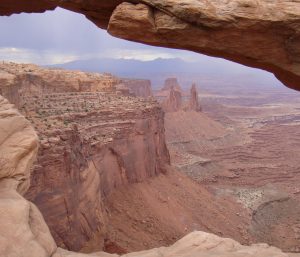
Weathering takes place in desert climates by the same means as other climates, only at a slower rate. This is besides the higher temperatures, which typically spur faster weathering. Water is the main agent of weathering, and lack of water slows weathering. Precipitation occurs in deserts, only less than in other climatic regions. Chemical weathering proceeds more slowly in deserts compared to more humid climates because of the lack of water. Even mechanical weathering is slowed, because of a lack of runoff and even a lack of moisture to perform ice wedging. However, when precipitation does occur, often in the form of flash floods, a large amount of mechanical weathering can happen quite quickly.
 CC BY-SA 3.0 or GFDL], via Wikimedia Commons" width="312px" height="208px" src="/@api/deki/files/7722/Newspaper_Rock_Full-300x200.jpg">
CC BY-SA 3.0 or GFDL], via Wikimedia Commons" width="312px" height="208px" src="/@api/deki/files/7722/Newspaper_Rock_Full-300x200.jpg">One unique weathering product of deserts is desert varnish. Also known as desert patina or rock rust, they are thin dark brown layers of clays and iron and manganese oxides that form on very stable surfaces within arid environments. The exact cause of the material is still unknown, though cosmogenic and biologic mechanisms have been proposed.
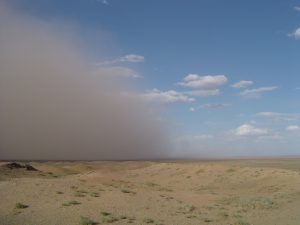
While water is still the dominant agent of erosion in most desert environments, wind is a notable agent of weathering and erosion in many deserts. This includes suspended sediment traveling in haboobs, or dust storms, that frequent deserts. Deposits of windblown dust are called loess. Loess deposits cover wide areas of the midwestern United States, much of it from dust that melted out of the ice sheets during the last ice age [7]. Lower energy than water, wind transport nevertheless moves sand, silt, and dust [8]. As noted in chapter 11, the load carried by a fluid (like air) is distributed among bedload and suspended load. As with water, in wind these components depend on wind velocity.
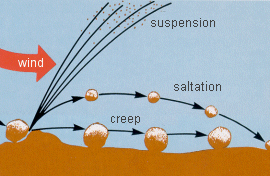
Sand size material moves by a process called saltation in which sand grains are lifted into the moving air and carried a short distance where they drop and splash into the surface dislodging other sand grains which are then carried a short distance and splash dislodging still others [8].
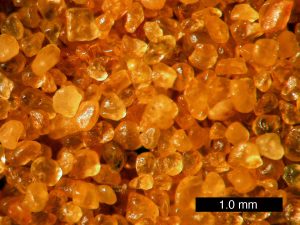
Since saltating sand grains are constantly impacting other sand grains, windblown sand grains are commonly pretty well rounded with frosted surfaces. Saltation is a cascading effect of sand movement creating a zone of windblown sand up to a meter or so above the ground. This zone of saltating sand is a powerful erosive agent in which bedrock features are effectively sandblasted. The fine-grained suspended load is effectively removed from the sand and the surface carrying silt and dust in haboobs. Wind is thus an effective sorting agent separating sand and dust-sized (≤70 µm) particles [9]. When wind velocity is high enough to slide or roll materials along the surface, the process is called creep.
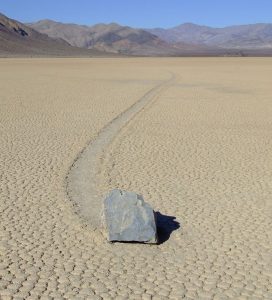
One extreme version of sediment movement was shrouded in mystery for years: Sliding stones. Also called sailing stones and sliding rocks, these are large moving boulders along flat surfaces in deserts, leaving trails. This includes the famous example of the Racetrack Playa in Death Valley National Park, California. For years, scientists and enthusiasts attempted to explain their movement, with little definitive results [10; 11]. In recent years, several experimental and observational studies have confirmed that thin layers of ice allow the stones to move with high winds providing propulsive energy [12; 13]. These studies include measurements of actual movement, as well as re-creations of the conditions, with resulting movement in the lab.
 Thomas Wilken at the German language Wikipedia [GFDL or CC-BY-SA-3.0], via Wikimedia Commons" width="240px" height="178px" src="/@api/deki/files/7726/13.7_Yardang_Im_Salar_de_Uyuni-300x223.jpg">
Thomas Wilken at the German language Wikipedia [GFDL or CC-BY-SA-3.0], via Wikimedia Commons" width="240px" height="178px" src="/@api/deki/files/7726/13.7_Yardang_Im_Salar_de_Uyuni-300x223.jpg"> CC0], via Wikimedia Commons" width="217px" height="201px" src="/@api/deki/files/7728/13.8_VentifactMojaveDesert031511-300x278.jpg">
CC0], via Wikimedia Commons" width="217px" height="201px" src="/@api/deki/files/7728/13.8_VentifactMojaveDesert031511-300x278.jpg">The zone of saltating sand is an effective agent of erosion through sand abrasion. A bedrock outcrop which has such a sandblasted shape is called a yardang [14]. Rocks and boulders lying on the surface may be blasted and polished by saltating sand. When predominant wind directions shift, multiple sandblasted and polished faces may appear. Such polished desert rocks are called ventifacts [15].
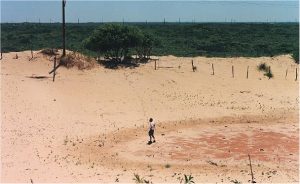
In places with sand dunes, clumps of vegetation often anchor sediment that has accumulated on the desert surface. Yet, saltation from winds may be sufficient to move or remove materials not anchored by vegetation. This causes a bowl-shaped depression in the sand called a blowout [16].
References
8. Bagnold, R. A. The physics of blown sand and desert dunes. Methum, London, UK 265 (1941).
9. Shao, Y. Physics and Modelling of Wind Erosion. (Springer Science & Business Media, 2008).
14. Hedin, S. A. Central Asia and Tibet. 1, (Hurst and Blackett, limited, 1903).
16. Livingstone, I. & Warren, A. Aeolian geomorphology: an introduction. (Longman, 1996).


